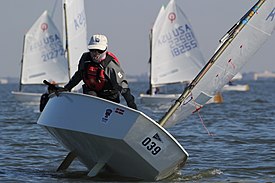Optimist dinghy

Class symbol
|
|
 |
|
| Location | International |
|---|---|
| Design | One-Design |
| Crew | 1 |
| Draft | 5 in (130 mm) 2 ft 9 in (0.84 m) |
| Type | Monohull |
| Construction | Fibreglass |
| Hull weight | 77 lb (35 kg) |
| LOA | 7 ft 9 in (2.36 m) |
| LWL | 7 ft 2 in (2.18 m) |
| Beam | 3 ft 8 in (1.12 m) |
| Keel/Board Type | ((daggerboard or centreboard)) |
| Rig Type | Sprit-Rigged |
| Mast Length | 7 ft 5 in (2.26 m) |
| Mainsail area | 35 sq ft (3.3 m2) |
| Jib / Genoa area | None |
| Spinnaker area | None |
| D-PN | 123.6 |
| RYA PN | 1646 |
The Optimist is a small, single-handed sailing dinghy intended for use by children up to the age of 15. Nowadays boats are usually made of fibreglass, although wooden boats are still built.
It is one of the most popular sailing dinghies in the world, with over 150,000 boats officially registered with the class and many more built but never registered.
The Optimist is recognised as an International Class by the International Sailing Federation.
The Optimist was designed in 1947 by American Clark Mills at the request of the Clearwater Florida Optimist service club following a proposal by Major Clifford McKay to offer low-cost sailing for young people. He designed a simple pram that could be built from three sheets of plywood, and donated the plan to the Optimists. The design was slightly modified and introduced to Europe by the Dane, Axel Damgaard, and spread outwards across Europe from Scandinavia. The design was standardized in 1960 and became a strict One-Design in 1995.
The Optimist is sailed in over 120 countries and it is one of only two yachts approved by the International Sailing Federation exclusively for sailors under 16.
The single sail of the Optimist is sprit-rigged. Two battens stiffen the leech. It is secured evenly with ties along the luff to the mast and along the foot to the boom, pulled down tightly by a vang/kicker. The light, slim third spar, the sprit, extends through a loop at the peak of the sail; the bottom rests in the eye of a short cable or string which hangs along the front edge of the mast. Raising and lowering the sprit and adjusting the boom vang allow for adaptation of sail trim to a range of wind conditions. Similarly, the Optimist has a small string outhaul on the end of the boom. It is usually correct to tighten the boomvang, outhaul, and sprit in heavy winds and loosen them in light winds. As well as this, huge adjustments can be made to sail shape, due to all of the ties running along the mast and boom.
...
Wikipedia
